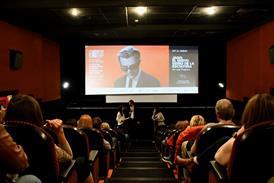Film Bazaar panel looks at new ways to connect non-Bollywood films with audiences.
In a country where Indian cinema is synonymous with Bollywood, what are the options out there for independent filmmakers to get their films to the audience?, asked Anurag Kashyap at Film Bazaar’s Knowledge Series ‘New Voices: The Filmmaker – Pushing Boundaries in Content Creation, Marketing and Monetising’.
“In India, filmmakers will make sure their films are made, but don’t always make sure they’re seen,” he pointed out. But panelists Amit Masurkar and Bardroy Barretto who have gone all out, in very different means, to bring their films to the audience.
Masurkar first released his debut feature Sulemani Keeda the traditional way in cinemas - in seven cities last December; followed almost immediately by an online release via The Viral Fever on YouTube.
“I’m fully aware that we wouldn’t be able to recoup from the theatrical release, but we need it to let people know the film, before we could put it up online,” said Masurkar.
The slacker comedy, which has attracted 40,000 viewers who paid a fee comparable to the cost of a bottle of beer in India, has become the first known online success of an independent film. “It’s important to release a film in the right platform and find the right distribution online model. This model with TVF works for my film, but I’m not sure if it works for big budget films,” he said.
With a four million rupees budget — low by India’s standards — Masurkar was able to recoup his film also from ancillary sales. The film was sold to Channel 4 in the UK and will be available on Netflix India when it launches.
Barretto, on the other hand, has taken a road less travelled for the release of his feature debut, Nachom-ia Kumpasar. Special screenings are being held for his film from town to town and from region to region, like in the old days.
“There are two theatres in the town I grew up. We would wait for one year before the film that we’ve seen on a poster to get to our town,” he said. “Now be patient for my film. We will come to you. It’s like we have gone back to what we were doing.”
Barretto knew well it was not the Hindu or English audience that he wanted, but his own people especially in Goa where he is from. The musical film was crowd-funded and was made in Konkani-language as a tribute to the Konkani musicians of the 1960s.
Kashyap said that he could not do what Barretto was doing, while what Masurkar did was intelligent – he worked around with the resources available and keep his creativity in his hands.
“The higher the budget, the less control you’ve. Do it your way within your cost. The people who hold the string will dictate you,” said the director of Gangs of Wasseypur.







![The Brightest SunScreen[Courtesy HKIFF]](https://d1nslcd7m2225b.cloudfront.net/Pictures/274x183/3/5/0/1448350_thebrightestsunscreencourtesyhkiff_312678.jpg)

















No comments yet